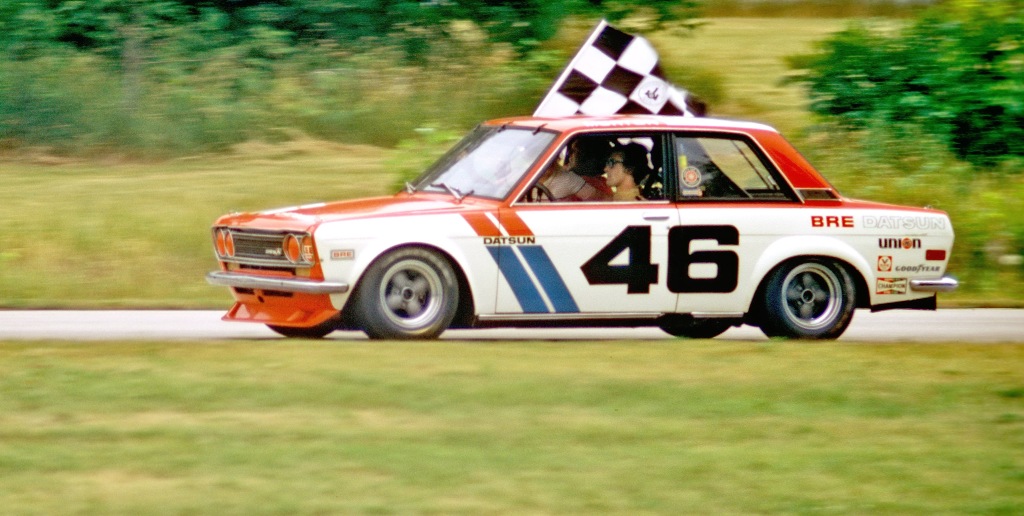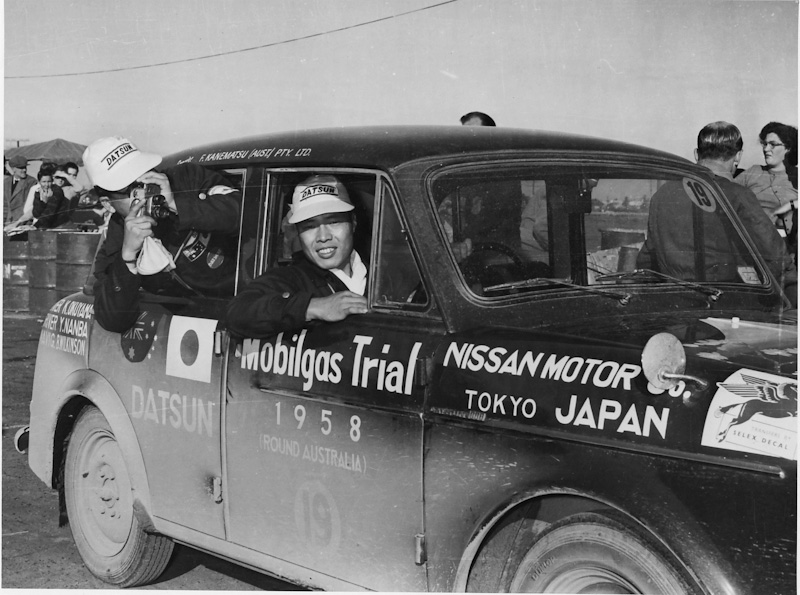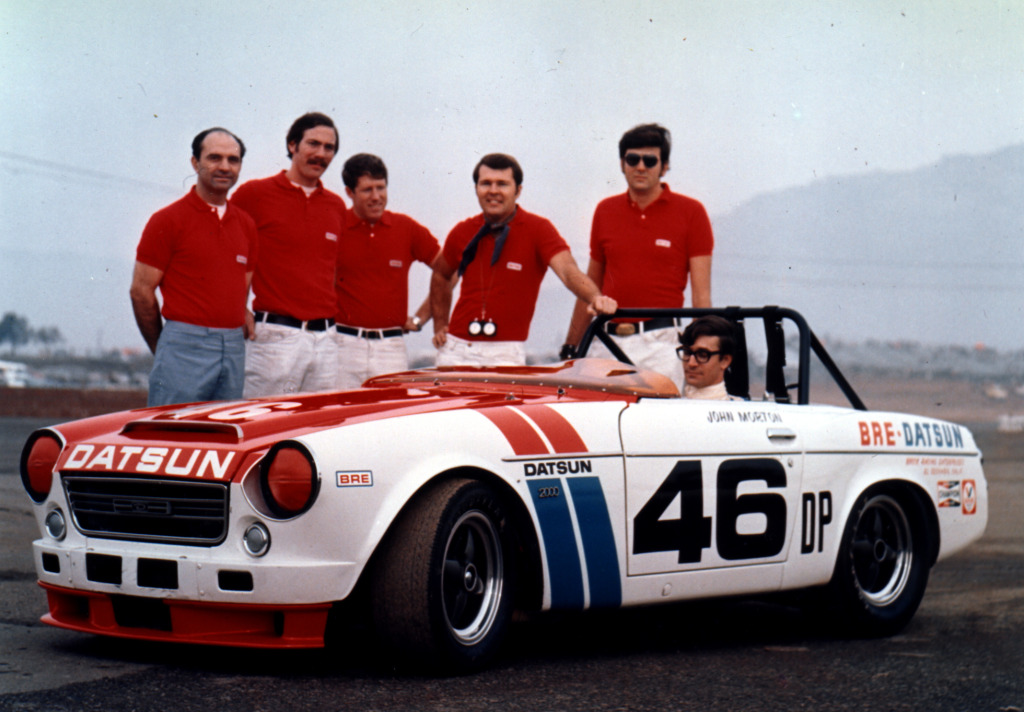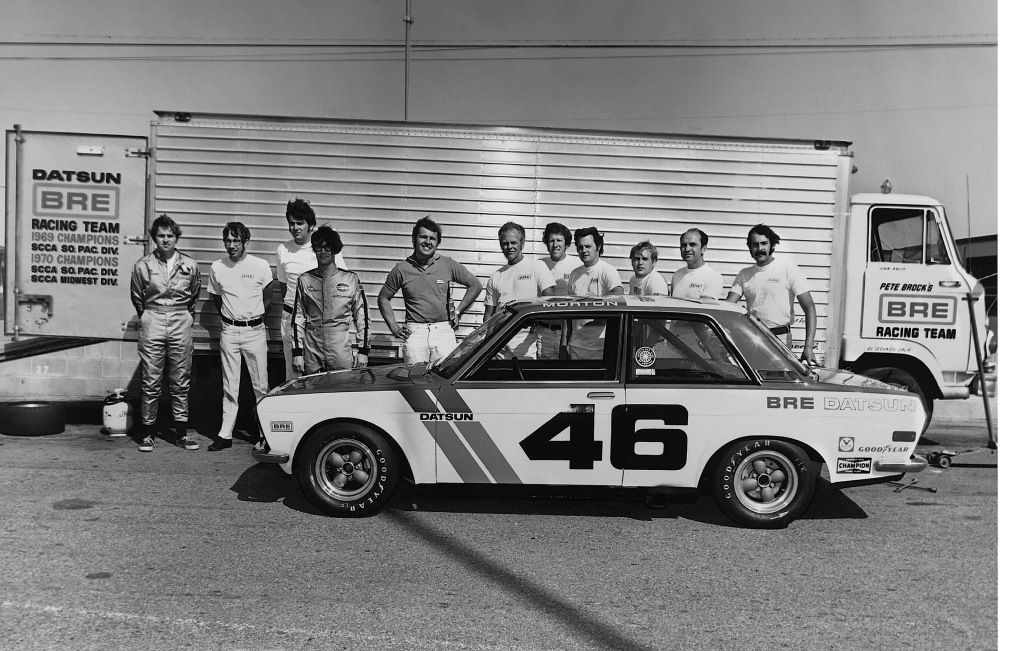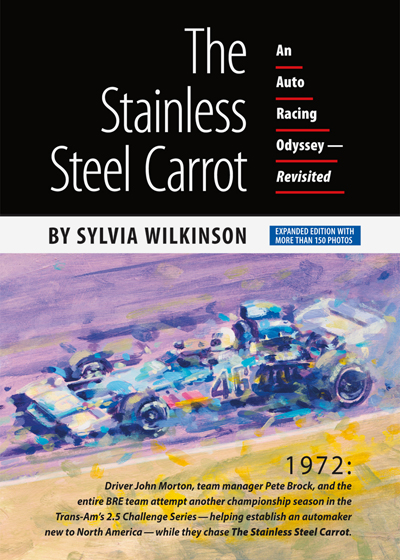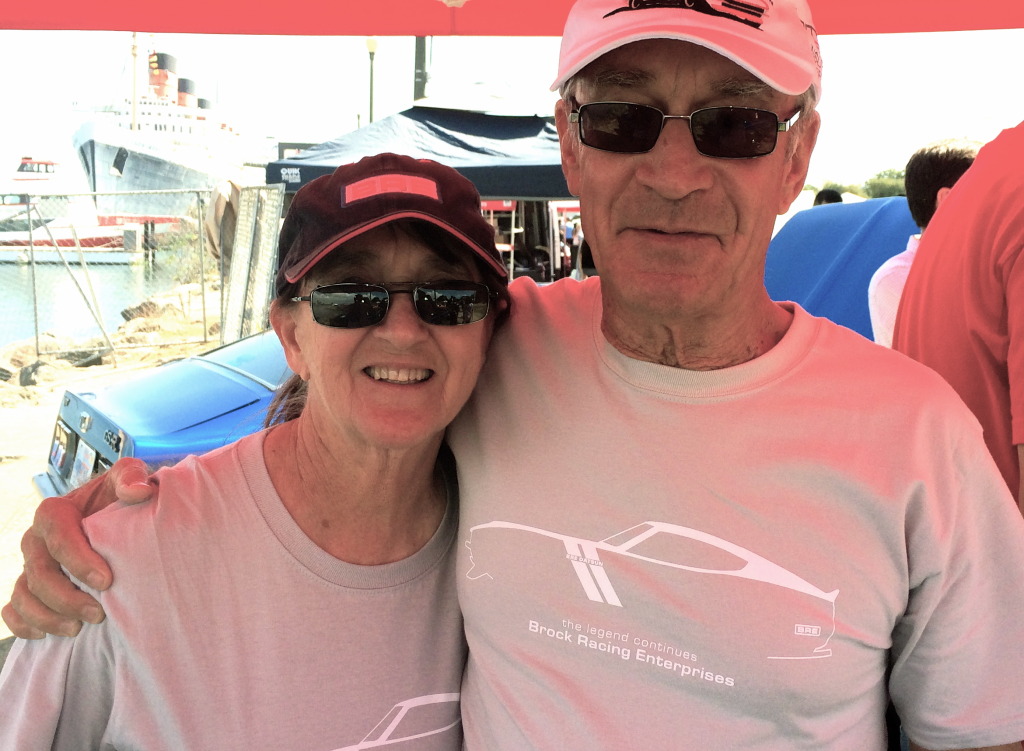By Steve Laser
Nissan has a rich history winning races in the showroom and on the racetrack. Today’s collector car favorites like the Datsun Roadster, 510 and 240Z have inspired professional and amateur racers to take to the track since they were new.
John Morton pilots the now legendary Datsun 510 #46 to victory at Road America in 1971. (photo by Tom Schultz)
The story of Datsun’s early days of American racing is one of persistence and determination – burning the midnight oil and challenging huge obstacles to success. Whether you witnessed this era firsthand or watched vintage Datsun racing videos on YouTube, it’s an inspiring story worth telling again.
Let’s travel back to the glory days of the early 1970s when Brock Racing Enterprises (BRE) team driver John Morton raced Datsuns. His quest for the checkered flag is chronicled in The Stainless Steel Carrot: An Auto Racing Odyssey — Revisited, by Sylvia Wilkinson. Originally published in 1973, this non-fiction account tells a compelling story of the heyday of Datsun racing.
Before we go racing, let’s take a closer look at how the 510 became Datsun’s first successful mass-market vehicle in the U.S.
Building a Strong Competitor
It’s likely the 510 would not have been considered as a racecar without Yutaka Katayama. The charismatic “Mr. K.” was Nissan’s first president in the U.S. and an avid auto enthusiast. Prior to coming to the states, he directed a factory backed team that garnered Nissan’s first international racing victory with a class win in the grueling 10,000-mile Australian Mobilgas Trial rally.
Datsun establishes its name in racing during the Mobilgas Trial rally.
Datsun’s early sedans had been considered underpowered and not well-suited to American highways. Mr. K targeted the popular BMW 1600 2-door as the benchmark for the new 510.
Thus it would have front disc brakes, an independent rear suspension, a fully synchronized 4-speed manual transmission or optional automatic, and a single-overhead cam 1.6-liter 4-cylinder engine that put out 96 horsepower. But with a price tag of less than $2,000 — compared to $5,000 for the BMW 1600 — it quickly earned a reputation as the “poor man’s BMW.”
The Datsun 510 began its illustrious career as a rugged compact economy sedan fitted with an independent rear suspension.
Introduced in 1968, the 510 put Datsun on the map with U.S. buyers while its sophisticated engineering surpassed Volkswagen, the import leader, and Toyota’s sedans of the era. Easy to modify, the 510 also has the distinction of launching the “tuner car” craze for import sedans that continues to flourish today.
BRE’s Datsun Dream Team
As the 1970s began, the 510 found success at the racetrack in the hands of the BRE racing team. Led by owner Pete Brock, BRE had established a strong track record racing Datsuns prior to taking on the 510. The dominance began with a BRE Datsun 2000 roadster in the Sports Car Club of America’s (SCCA) Pacific Coast D class in the late 1960s. The team followed up with two successive wins in SCCA C production with Mr. K’s other prodigy, the Datsun 240Z.
Pete Brock (fourth from left) and his team stand by the BRE Datsun 2000 with John Morton at the wheel.
Datsun and Nissan have enjoyed many victories over the years in a variety of classes on racetracks across the country. Yet the seasons that stand out in the record books as well as the memories of Datsun racing fans are 1971 and 1972. That’s when John Morton piloted his now legendary Datsun 510 #46 to two successive victories in the SCCA’s Trans-Am 2.5 class.
This class was created for teams seeking to race imported cars with small-displacement engines. Thus the 510 ran against tough competition including BMW and Alfa Romeo. The path to victory was filled with many bumps in the road.
As the end of the ’71 season approached, the winner of the 2.5 class would be decided during the last race at Monterey, California. It was Morton in his BRE 510 vs. Horst Kwech driving an Alfa Romeo GTV.
Morton and Brock (fourth and fifth from left) supported by the BRE team made history on the racetracks of the 1970s.
The race had some intense moments that Morton recalled in the book’s second chapter. “When Kwech hit me in the corkscrew, I thought it was intentional and he was out to get me. Then I got in front again and he hit me again, bang, bang, bang, five times in turn nine, I stayed in front of him but lost some time sideways and he outdragged me up the hill.”
Kwech crossed the finish line ahead of Morton. Yet it turned out that the Alfa team had not followed the rules. At post-race inspection, the chief technical inspector called for a gas check. The cars were limited to 15-gallon tanks, yet the check revealed that the Alfa’s tank held 18.1 gallons, causing it to be disqualified.
“If I had to cheat to win a race, winning it would mean nothing,” said Morton. “It would mean I didn’t give my competition a fair shot. Horst and I could exhibit our driving abilities and have fun racing, but whoever installed the illegal tank cancelled the meaning of the race.”
Drama Behind the Scenes
With the ’71 season behind them, the BRE team and Morton went on to win the 2.5-class title for ’72. The Stainless Steel Carrot highlights the action during events at legendary tracks including Lime Rock, Watkins Glen, Elkhart Lake, and Road Atlanta.
Morton’s victory at the season finale in Riverside, California was bittersweet. “There is no race queen, no trophy, no celebration at Riverside,” wrote Wilkinson. “In the embarrassing scene in the winner’s circle, Joe Henderson, the SCCA series steward, presents John his old fishing hat because no one has provided a trophy.”
With BRE’s support and Morton’s driving skills, the 510 accomplished more than anyone imagined. Unfortunately, SCCA dropped the 2.5 class at the conclusion of the season, bringing this 510 saga to a close. BRE briefly experimented with NHRA drag racing, Bonneville Salt Flats time trials, and a Formula 5000 program where their only race car was demolished.
Wilkinson weaves vivid images of Morton’s quest to move up in the racing world — the inspiration for the book’s title. “We kid a lot in the shop about the stainless steel carrot, like a donkey going after something that you can’t obtain but you keep going after it because it is dangling there to motivate you,” Morton said.
Like many young racers, Morton dreamed of the big time. He longed to make the leap to open-wheel racing and eventually compete at Indy and Formula One. Yet at the close of the 1972 season, he and Brock instead drove a Datsun 510 at the grueling Mexican 1000, the 950-mile race in Baja.
“I really can’t get all jazzed about that kind of racing,” said Morton. “We were trying but after we got screwed up and stuck for so long, it wasn’t a race anymore. It was just a long trip down a bad road.”
As a young driver with great potential, Morton continued his career racing a variety of cars across the globe. The Stainless Steel Carrot is illustrated with more than 150 photos showing John racing an IMSA Datsun Z in 1974–’76, a BMW CSL for Vasek Polak in ’78, a Ferrari at Daytona in ’78, a Porsche 962 at Road America in ’85, and a Porsche 956 at Le Mans in ’86.
Morton had a violent crash driving the Nissan GTP car at Lime Rock in ’88, receiving minor injuries. He recovered and got back in the cockpit, scoring class wins with Cunningham Racing’s Nissan 300ZX at LeMans and Sebring in ’94. He passed the rookie test at Indy but without funding was not able to race. More recently, Morton competed in Monterey Historic races, driving cars like a Cobra Daytona Coupe and 1958 Scarab.
Fast Forward 40 Years
The last chapter, “Forty Years On — Revisiting an Auto Racing Odyssey,” catches up with Morton and BRE team members today. “When I raced the 510, I never imagined it would be duplicated,” said Morton. “Now there are hundreds of them.”
Datsun 510s and vintage Z cars have become cult classics with enthusiasts. During its heyday, BRE made an aftermarket business selling Datsun parts to aspiring racers and enthusiasts. When BRE closed, Brock redirected his efforts to hang gliders and ultralight aircraft, later becoming an automotive writer.
Mr. K returned to Japan and was inducted into the U.S. Automotive Hall of Fame in 1998 for his lifetime contributions and later the Japan Automotive Hall of Fame in 2008. He still loves cars at the well-seasoned age of 105.
John Morton and Sylvia Wilkinson team up today at a car show in Long Beach, Calif. (Photo © CarNichiWa.com)
In addition to writing The Stainless Steel Carrot, Wilkinson was an automotive racing timer and scorer for many years, for drivers including Paul Newman, Al Unser, Sr., Bobby Rahal and Keke Rosberg. She has published more than two-dozen books ranging from novels for adults, non-fiction works and juvenile titles with automotive themes. And to prove this story has a happy ending, Wilkinson and Morton have been together for more than 40 years.
Morton recently wrote a book about his early days working for Carroll Shelby prior to joining the BRE team. And he tagged along as an observer while his daughter, who is not involved in racing, participated in a class at the Bondurant School of High Performance Driving. “They let us take a lap together at the end of the course in a Cobra just for fun,” said Morton.
Wilkinson agreed to reissue The Stainless Steel Carrot as a benefit to animals, both wild and domestic. Royalties from book sales go to animal and environmental groups and wildlife funds.
The Stainless Steel Carrot is 365 pages of Datsun-Nissan racing history that belongs in the libraries of Nissan admirers, racing fans, and auto enthusiasts everywhere.
Retail book purchases can be made online at stainlesssteelcarrot.com.
[Images (unless credited otherwise) are courtesy of the Nissan historical collection and The Stainless Steel Carrot.]
Story (commentary) © 2014 CarNichiWa.com
